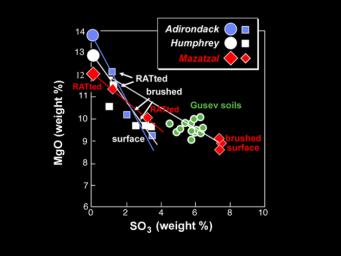
|
What’s on the Inside Counts
- Click the image above for a larger view
- Full-Res JPEG (720 x 540) (35.2 kB)
- Full-Res TIFF (720 x 540) (142.0 kB)
Caption:
This graph shows the chemical composition of the rock at Gusev Crater dubbed "Mazatzal" after it was brushed and ground by the Mars Exploration Rover Spirit's rock abrasion tool. The data, taken by the rover's alpha particle X-ray spectrometer, show that Mazatzal's interior possesses approximately the same quantities of magnesium oxide and sulfur tri-oxide as other basalt rocks in the Gusev Crater area ("Adirondack and "Humphrey"). It's exterior coating or rind, on the other hand, appears to be of a different chemical composition than the previously studied rocks. Concentrations of magnesium oxide were observed to increase first with brushing, then grinding. Also represented on the graph is soil found near Mazatzal, which appears to have a different make-up from the rock itself. Scientists are still puzzling out the implications of these data.
The larger symbols on the graph represent inferred rock compositions, while the smaller symbols are actual data points. Observations were made at the target dubbed "New York" on Mazatzal.
Cataloging Keywords:
| Name | Value | Additional Values |
|---|---|---|
| Target | Mars | |
| System | ||
| Target Type | Planet | |
| Mission | Mars Exploration Rover (MER) | Mars Science Laboratory (MSL) |
| Instrument Host | Spirit (MER-A) | Curiosity Rover |
| Host Type | Rover | |
| Instrument | Alpha Particle X-Ray Spectrometer (APXS) | Rock Abrasion Tool (RAT) |
| Detector | ||
| Extra Keywords | Color, Crater | |
| Acquisition Date | ||
| Release Date | 2004-04-01 | |
| Date in Caption | ||
| Image Credit | NASA/JPL/Cornell/Max Planck Institute | |
| Source | photojournal.jpl.nasa.gov/catalog/PIA05675 | |
| Identifier | PIA05675 | |
